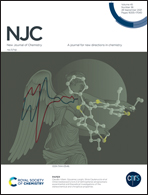Graphite-like structure of disordered polynaphthalene hard carbon anode derived from the carbonization of perylene-3,4,9,10-tetracarboxylic dianhydride for fast-charging lithium-ion batteries
Abstract
In order to develop novel fast charge/discharge carbon anode materials, an organic hard carbon material (PTCDA-1100) is obtained by calcination of perylene-3,4,9,10-tetracarboxylic dianhydride (PTCDA) at a high temperature of 1100 °C. The obtained PTCDA-1100 sample has a disordered porous nanostructure, large specific surface area, and more exposed active points, providing channels for the rapid transport of lithium ions. As a result, the PTCDA-1100 electrode shows superior lithium storage behavior compared to conventional commercial graphite materials when used as a negative anode material for lithium-ion batteries. When the PTCDA-1100 electrode is charged and discharged at the small current rate of 0.2C, the initial capacity of the electrode is 320.7 mA h g−1, which is very close to that of graphite (329.5 mA h g−1). However, as the cycles increase, after 100 cycles, the capacity of the PTCDA-1100 electrode is 290.9 mA h g−1 with a retention rate of 90.7%, which are significantly higher than the capacity of graphite (231.3 mA h g−1) and its retention rate of 70.2%. Similarly, at all other high current rates of 1C, 3C and 5C, the PTCDA-1100 electrode is significantly better in both capacity and cycle stability than the commercial graphite electrode. Overall, the PTCDA-1100 organic hard carbon materials prepared in this work show better cyclic stability and rate capability both in half and full batteries compared to commercial graphite material, which would provide new ideas for developing novel carbon negative materials for fast charge and discharge of lithium-ion batteries.



 Please wait while we load your content...
Please wait while we load your content...